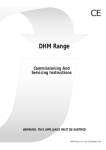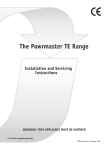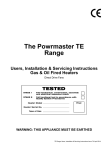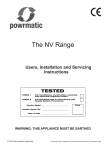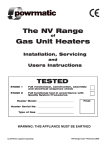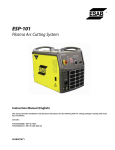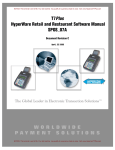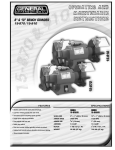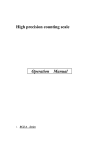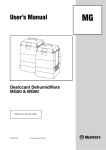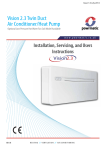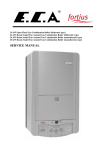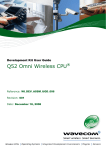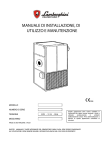Download CPEAG Installation Manual
Transcript
CE The NCE-AG and CPE-AG Ranges Range Commissioning And Servicing Instructions WARNING: THIS APPLIANCE MUST BE EARTHED NCVE-AG/CPE-AG Range Issue 5 April 2003 CONTENTS Section Title Page 1. 2. 3. 4. 5. 6. 7. 8. 2 3 5 6 7 7 8 9. 10. Introduction Technical Data General Requirements Installation Air Distribution System Commissioning & Testing Servicing Connections to Powrmatic External Controls Fault Finding Short List of Parts Tables Title Page 1a. 1b. 1c. 1d. 2a. 2b. 3.1 3 3 4 4 4 4 3.2 4. Dimensions NCE-AG (S.I. Units) Dimensions NCE-AG (Imperial Units) Dimensions CPE-AG (S.I. Units) Dimensions CPE-AG (Imperial Units) Specifications (S.I. Units) Specifications (Imperial Units) Burner Pressures - Natural Gas Group H - G20 Burner Pressures - Propane - G31 Electrical Loadings 4 4 4 Figure Title Page 1. 2. Honeywell V4400C Honeywell L4064N 8 10 1 10 11 12 1. INTRODUCTION The Powrmatic NCE-AG and CPE-AG ranges of gas fired open flue, fanned circulation air heaters cover a heat output range of 29.3 kW (100000 Btu/h) to 88.0 kW (300000 Btu/h) and are intended primarily for heating commercial or industry premises. They are certified for use on Natural Gas, Group H - G20 and Propane - G31. The heaters are for floor mounting only and are available in UF and UD variants. (U - Upright; F - Freeblowing; D - Ducted). NCE-AG and CPE-AG heaters have a centrifugal fan assembly fitted upstream of the combustion chamber / heat exchanger assembly to circulate the air being heated. Heaters are fitted as standard with a single venturi inshot atmospheric gas burner and permanent pilot together with a multifunctional gas control. Options include Deep V filters, proportional air dampers and inlet and outlet duct spigots. Each air heater must be connected to a open flue system only. Gas Safety (Installation & Use) Regulations 1994 It is law that all gas appliances are installed, adjusted and, if necessary, converted by qualified persons* in accordance with the above regulations. Failure to install appliances correctly can lead to prosecution. It is in your own interests and that of safety to ensure that the law is complied with. * e.g. Corgi Registered 2 2 Technical Data 2.1 Dimensions D F E G C NCE-AG 100UF SHOWN J K H B FRONT VIEW A D F SIDE VIEW E G CE-AG 300UF SHOWN C J K A H B FRONT VIEW Table 1a. Dimensions NCE-AG (S.I. Units) A B C D E F G H J K NCE-AG 100 1340 631 1820 277 250 200 2629 527 533 705 NCE-AG 200 1390 730 2077 301 280 200 3182 629 580 756 Table 1b. Dimensions NCE-AG (Imperial Units) A B C D E F G H J K NCE-AG 100 52¾ 24¾ 71¾ 11 10 8 103½ 20¾ 17¾ 27¾ NCE-AG 200 57¾ 28¾ 81¾ 11¾ 11 8 125¼ 24¾ 24¾ 29¾ 3 SIDE VIEW Table 1c. Dimensions CPE-AG (S.I. Units) A B C D E F G H J K CPE-AG 100 809 631 1820 277 250 200 2629 527 533 705 CPE-AG 200 855 730 2077 301 280 200 3182 629 580 756 CPE-AG 300 1060 908 2356 329 320 250 3455 806 525 959 Table 1d. Dimensions CPE-AG (Imperial Units) A B C D E F G H J K CPE-AG 100 31¾ 24¾ 71¾ 11 10 8 103½ 20¾ 21 27¾ CPE-AG 200 33¾ 28¾ 81¾ 11¾ 11 8 125¼ 24¾ 23 29¾ CPE-AG 300 41¾ 35¾ 92¾ 13 12½ 10 136 31¾ 20¾ 37¾ Table 2a - Specifications (S.I. Units) HIGH FIRE MODEL INPUT (Nett) OUTPUT MAXIMUM DUCT RESISTANCE AIR VOLUME kw Standard m³/s L.H.P. FAN MOTOR Standard pa WEIGHT L.H.P. GAS CONNECTION SIZE kg kw NCE/CPE-AG 100 33.5 29.3 0.7340 100 N/A 0.335 N/A NCE/CPE-AG 200 68.9 58.6 1.5575 250 N/A 1.5 N/A CPE-AG 300 103.5 88.0 2.0766 150 N/A 2.2 N/A 167 R¾ 296 381 Table 2b - Specifications (Imperial Units) HIGH FIRE MODEL INPUT (Gross) OUTPUT MAXIMUM DUCT RESISTANCE AIR VOLUME Btu/h Standard ft³/m L.H.P. FAN MOTOR Standard in wg WEIGHT L.H.P. GAS CONNECTION SIZE lb hp NCE/CPE-AG 100 126984 100000 1555 0.40 N/A 0.47 N/A NCE/CPE-AG 200 261438 200000 3300 1.00 N/A 2.0 N/A CPE-AG 300 392157 300000 4400 0.60 N/A 3.0 N/A 367 ¾"BSP 651 840 Table 3.1 Burner Pressures - Natural Gas - Group H - G20 - Net CV (Hi) = 34.02MJ/m³ Injector Siz e Pilot R ate Type mm in A1 5.0 0.196 N C E/C PE-AG 200 A2 7.00 0.275 C PE-AG 300 A3 8.5 0.334 N C E/C PE-AG 100 kW 0.1 Main B urner Pressure Gas R ate mbar in w g m³/h ft³/h 13.0 5.2 3.54 125.0 11.0 4.4 7.29 257.4 11.3 4.5 10.81 381.7 Table 3.2 Burner Pressures - Propane - G31 - Net CV (Hi) = 88.00MJ/m³ Type NCE/CPE-AG 100 A1 Injector Siz e Pilot Rate mm in 3.2 0.125 kW NCE/CPE-AG 200 A2 4.6 0.181 CPE-AG 300 A3 5.61 0.220 Table 4 0.1 Main Burner Pressure mbar in w g m³/h ft³/h 23.3 1.37 48.4 9.3 25.3 10.1 2.82 99.6 24.8 10.0 4.18 147.6 Electrical Loadings Standard MOTOR MODEL ph R.P.M. NCE/CPE-AG 100 NCE/CPE-AG 200 CPE-AG 300 Gas Rate 1 3 1000 Larger Horsepower Motor PLATE AMPS (A) START AMPS (A) FUSE MOTOR RUN AMPS RATING (A) (A) R.P.M. 2.6 5.6 2.9 5 7.0 18.0 8.1 10 6.7 14.0 6.0 7 PLATE AMPS (A) START AMPS (A) N/A 4 RUN AMPS (A) FUSE RATING (A) 3.3.2 Meters 3. General Requirements A gas meter is connected to the service pipe by the local gas undertaking or a local gas undertaking contractor. An existing meter should be checked, preferably by the gas undertaking, to ensure that the meter is adequate to deal with the total rate of gas supply required. 3.1 Related Documents The installation of the air heater(s) must be in accordance with the rules in force and the relevant requirements of the Gas Safety Regulations, Building Regulations and the I.E.E. Regulations for Electrical Installations. It should be in accordance also with any relevant requirements of the local gas region, local authority and fire authority and the relevant recommendations of the following documents. 3.3.3. Installation Pipes Installation pipes should be fitted in accordance with IM/16:1988. Pipework from the meter to the air heater must be of adequate size. Do not use pipes of a smaller size than the inlet gas connection of the heater. The complete installation must be tested for soundness as described in the above Code. The complete installation must be tested for soundness as described in BS 6230. British Gas Plc Publications IM/11 : 1989 Flues for Commercial and Industrial Gas Fired Boilers and Air Heaters IM/16 : 1988 Guidance notes for the installation of gas pipework, boosters and compressors in Customer’s premises (excluding domestic installation of 25mm and below). 3.3.4. Boosted Supplies Where it is necessary to employ a gas pressure booster the controls must include a low pressure cut off switch at the booster inlet. The local gas undertaking must be consulted before a gas pressure booster is fitted. The maximum inlet pressure is 60mb. British Standards Code of Practice BS 5588 Fire precautions in the design and construction of buildings. Part 2 : 1985 Code of Practice for Shops Part 3 : 1983 Code of Practice for Office Buildings BS 6230: 1991 Installation of Gas Fired Forced Convection Air Heaters for Commercial and Industrial Space Heating. 3.4 Flue System Detailed recommendations for fluing are given in BS 5440, Part 1 (Flues) and IM/11. The air heater must be connected to an open flue system. The cross sectional area of the flue serving the appliance must be not less than the area of the flue outlet of the draught diverter flue socket. Materials used for the flue system should be mechanically robust, resistant to internal and external corrosion, noncombustible and durable under the conditions to which they are likely to be subjected. Prevention of condensation within the flue should be an important factor in the design of the flue system. In order to minimise condensation the use of double walled flue pipe or insulation is recommended. If double walled flue pipe is used it should be of an acceptable type. Where condensation in the flue is unavoidable provision should be made for condensation to flow freely to a point at which it can be released, preferably into a gully. The condensation pipe from the flue to the disposal point should be of non-corrodible material of not less than 22mm (1/2") size. Facilities should be made for disconnecting the flue pipe(s) from the air heater(s) for inspection and servicing purposes. Bends with removable covers should be fitted for inspection and cleaning purposes where considered appropriate. The flue should terminate in a freely exposed position and must be so situated as to prevent the products of combustion entering any opening in a building in such concentration as to be prejudicial to health or a nuisance. An approved terminal must be fitted. Those appliances having an input rating not exceeding 60kW viz. NCE-AG 100 and CPE-AG 100 must be installed in accordance with the relevant recommendations of the following documents. BS 5440 Flues and Air Supply for gas appliances of rated input not exceeding 60kW (1st and 2nd family gases). Part 1 - Flues, Part 2 - Air Supply For NCE-AG 100 and CPE-AG 100 units reference should also be made to BS 5864. Code of Practice for installation of gasfired ducted-air heaters of rated input not exceeding 60kW. 3.2 Location The location chosen for the air heater must permit the provision of a satisfactory flue system and an adequate air supply. The location must also provide adequate space for servicing and air circulation around the air heater. The heater(s) must not be installed in conditions for which it is not specifically designed e.g. where the atmospheric is corrosive or salty and where high wind speeds may affect burner operation, and they are not suitable for outdoor use. Where the location of the air heater is such that it might suffer external mechanical damage e.g. from overhead cranes, fork lift trucks, it must be suitably protected. NCE-AG and CPE-AG units are designed to operate in a maximum ambient temperature of 25 °C. 3.3 Gas Supply 3.5 Air Supply In buildings having a design air change rate of less than 0.5 /h, and where NCE-AG and CPE-AG heaters are to be installed in heated spaces having a volume less than 4.7 m3 / kW of total rated heat input grilles shall be provided at low level as follows:(1) for heaters of heat input less than 60 kW, the 3.3.1 Service Pipes The local gas undertaking should be consulted at the installation planning stage in order to establish the availability of an adequate supply of gas. An existing service pipe must not be used without prior consultation with the local gas undertaking. 5 (2) total minimum free area shall not be less than 4.5 cm2 per kilowatt of rated heat input. for heaters of heat input 60 kW or more, the total minimum free area shall not be less than 270cm2 plus 2.25 cm2 per kilowatt in excess of 60 kW rated heat input. fully ducted, in to and out of the plant room to avoid interference with the operation of the burner and flue by the air circulation fan. The openings in the structure of the plant room through which the ducting passes must be fire stopped. Care must be taken to ensure that return-air intakes are kept clear of sources of smells and fumes, and in special circumstances where there is any possibility of pollution of the air by dust, shavings etc., precautions must be taken by carefully positioning return air intakes and by the provision of screens to prevent contamination. In addition, where there is a risk of combustible material being placed close to the warm air outlets, suitable barrier rails should be provided to prevent any combustible material being within 900mm (3ft) of the outlets. Where the air heater(s) is to be installed in a plant room the plant room housing it must have permanent air vents communicating directly with the outside air, at high level and at low level. Where communication with the outside air is possible only by means of high level air vents, ducting down to floor level for the lower vents should be used. All air vents should have negligible resistance and must not be sited in any position where they are likely to be easily blocked or flooded or in any position adjacent to an extraction system which is carrying flammable vapour. Grilles or louvres should be so designed that high velocity air streams do not occur within the plant room. 3.7 Electrical Supply Wiring external to the air heater must be installed in accordance with the I.E.E. Regulations for Electrical Installations and any local regulations which apply. Wiring should be completed in flexible conduit. Heaters NCE-AG and CPE-AG 100 - 200 are supplied by 230V - 1ph, 50Hz,the CPE-AG 300 by 400V - 3N, 50Hz. The method of connection to the main electricity supply must facilitate the complete electrical isolation of the air heater(s) and the supply should serve only the air heater(s). The isolator must have a contact separation of at least 3mm in all poles. The method of connection should be provided adjacent to the air heater(s) in a readily accessible position. See the accompanying wiring diagram for the heater electrical connections The basic minimum effective area requirements of the air vents are as follows: (a) Low Level (inlet) (1) for heaters of total rated heat input less than 60 kW: 9 cm2 per kilowatt of rated heat input (2) for heaters of total rated heat input 60 kW or more: 540 cm2 plus 4.5 cm2 per kilowatt in excess of 60 kW total rated input. (b) High Level (outlet) (1) for heaters of total rated heat input less than 60 kW: 4.5 cm 2 per kilowatt of rated heat input; (2) for heaters of total rated heat input 60 kW or more: 270 cm2 plus 2.25 cm2 per kilowatt in excess of 60kW total rated input. 4. Installation of Air Heater(s) 4.1 General 3.6 Air Distribution System Before installation, check that the local distribution conditions, nature of gas and pressure, and adjustment of the appliance are compatible. The following notes are of particular importance. For free-blowing units it must be taken into account that the buoyancy of the heated air leaving the heater and air patterns within the space being heated will modify the air throw pattern achieved. In buildings having a low heat loss where single units are required to cover a large floor area and in buildings with high roof or ceiling heights Calecon thermal economiser units should be fitted to ensure even heat distribution and minimise stratification respectively. Care should be taken to avoid impeding the air throw with racking, partitions, plant or machinery etc. The air heater must be installed in accordance with the rules in force and the relevant requirements of any fire regulations or insurance company’s requirements appertaining to the area in which the heater is located, particularly where special risks are involved such as areas where petrol vehicles are housed, where cellulose spraying is carried out, in wood working departments etc. NCE AG and CPE AG heaters must not be installed in areas subjected to negative pressures due to extract systems. The following minimum clearances for installation and servicing must be observed. To the front The depth of the heater To the rear 1.0m (3.3ft) To at least one side 1.0m (3.3ft) Above the heater 1.00m (3.3ft) For ducted units all delivery and return air ducts, including air filters, jointing and any insulation or lining must be constructed entirely of materials which will not contribute to a fire, are of adequate strength and dimensionally stable for the maximum internal and external temperatures to which they are to be exposed during commissioning and normal operation. In the selection of materials account must be taken of the working environment and the air temperatures which will result when the overheat limit thermostat is being commissioned. Where inter-joist spaces are used as duct routes they should be suitably lined with a fire-resisting material. A full and unobstructed return air path to the air heater(s) must be provided. If the air heater(s) is installed in a plant room the return air intake(s) and the warm air outlet(s) from the heater(s) must be Any combustible material adjacent to the air heater and the flue system must be so placed or shielded as to ensure that its temperature does not exceed 65 °C (150 °F) IMPORTANT: 1. No air heater shall be installed where there is a foreseeable risk of flammable particles, gases vapours or corrosion inducing gases or vapours being drawn into either 6 the heated air stream or the air for combustion. In certain situations where only airborne particles are present it may suffice to fit filters on the air inlet ducts of the heater. Advice in these instances may be obtained from Powrmatic Ltd. 5. Air Distribution System 5.1 General NCE-AG ###UD and CPE-AG ###UD models are designed for use with duct work to more precisely define the point of air delivery, and /or provide ducted return air or ducted fresh air inlet. All ducting must be independently supported of the air heater. Joints and seams of supply ducts and fittings must be securely fastened and made airtight. 4.2 Fitting the Air Heater The heaters must be installed on a level noncombustible surface. If noise levels are of particular importance the heater should be insulated from the structure of the building by installing it on suitable anti-vibration mountings. In all such cases it is essential that all gas, duct, electrical and flue connections to the heater are made with flexible connections to maintain continuity of connection. In the case of the flue connection single wall stainless steel flue is deemed to flex sufficiently to meet the requirements. 5.2 Noise Reduction If deemed necessary consideration should be given to mounting the heater on resilient pads, or equivalent, to minimise transfer of noise and vibration to the structure of the building. It is recommended that ducting should be connected to the heater spigots via an airtight flexible coupling of noncombustible material. Before fitting coupling it must be ensured that a maximum clearance of 13mm (1/2") will be maintained between the ends of the ducting and the heater spigots. If required sound attenuators may be fitted in inlet and outlet ducts to reduce airborne fan noise. Materials used in outlet sound attenuators must be capable of withstanding 100 °C air temperature without any deterioration. 4.3 Connection of Air Heater(s) to Flue System A single wall 90° Bend and draught diverter assembly is supplied with each heater and must be fitted to the flue outlet socket on the heater. The flue system connects directly on to the draught diverter and must have a minimum length of 2.0m. For flue sizes refer to Tables 1a and 1b Page 4 . Horizontal runs of flue are not permitted. If necessary a single offset using two 45° bends can be included to avoid obstructions. 5.3 Room Thermostat Siting The room thermostat should be fitted at a point which will be generally representative of the heated area as far as temperature is concerned. Draughty areas, areas subjected to direct heat e.g. from the sun, and areas where the air movement is relatively stagnant e.g. in recesses, are all positions to be avoided for siting the thermostat. The thermostat should be mounted about 1.5m (5ft) from the floor. Any room thermostat, frost thermostat, time clock etc. must be suitable for switching 230V, 5A and must be of the 'snap action' type to minimise contact bounce. For electrical connections of external controls see the accompanying wiring diagram. 4.4 Condensate Drainage The design of the flue system should minimise the formation of condensation, however when this is envisaged to be a problem provision should be made for condensation to flow to a joint where it can be drained, preferably into a gully. 4.5 Gas Connection A servicing valve and downstream union must be fitted at the inlet to the air heater gas controls assembly to facilitate servicing . The gas supply to the air heater must be completed in solid pipework and be adequately supported. WARNING: When completing the final gas connection to the heater do not place undue strain on the gas pipework of the heater. 6. Commissioning & Testing 6.1 Electrical Installation 4.6 Electrical Connections Checks to ensure electrical safety must be carried out by a qualified person. All units are fully pre-wired and only require final connections for the incoming mains supply and completion of the control circuit (230V) via a room thermostat, time clock etc. The electrical supply must be run to a point adjacent to the heater and be suitably terminated to provide an isolation point that will prevent remote activation of the unit during servicing. The heater electrical panel is located behind the front panel and cable entry points are provided in the adjacent heater framework. Reference must be made to Table 4 (Page 6) to ascertain the electrical loading of the air heater(s) being installed so that cables of adequate cross-sectional area to safely carry that load are used for the electrical installation. The length of the conductors between the cord anchorage and the terminals must be such that the current carrying conductors become taut before the earth conductor if the cable or cord slips out of the cord anchorage. All external controls must be of an approved type. See the wiring diagram accompanying these instructions. 6.2 Gas Installation The whole of the gas installation, including the meter, should be inspected and tested for soundness and purged in accordance with the recommendations of IM/16:1988. 6.3 Air Distribution System The system should be checked to ensure that the installation work has been carried out in accordance with the design requirements. Particular attention should be given to the correct arrangement of delivery ducts and registers, return air ducts and grills and general adequacy of return air paths. For NCE-AG ###UD and CPE-AG ###UD heaters ensure that the total duct system resistance does not exceed the available air pressure of the equipment supplied refer to Table 2a & 2b (Page5). If the duct system resistance is less than the available 7 air pressure of the equipment supplied additional resistance must be introduced e.g. by adjustment of duct outlet nozzles and balancing of the duct system. 6. Once the pilot has been established, continue pressing the white start button for approximately 20 seconds and then slowly release. The pilot should remain alight. WARNING: Should the pilot be extinguished at any time, either intentionally or unintentionally, push in and release the red OFF button (Fig.1 - 2) and wait 3 minutes before attempting to relight the gas, then repeat steps 3-4 above. 7. Switch on the electricity supply at the isolator and the main burner will light. 8. SHUT OFF To interrupt all gas flow through the multifunctional control press the red OFF button. After waiting 3 minutes the appliance may be relit by following the previous instructions. 6.4 Checks before lighting the Air Heater The following preliminary checks should be made before lighting the heater(s) a) Ensure that the ELECTRICAL supply to the heater is switched OFF. b) Check that all warm air delivery outlets are open. c) Check that the thermostat is set at MAX. d) Check that the clock control is set to an ON period. e) Check that any other controls are calling for heat. f) Ensure that the Summer/Winter switch is in the Winter position. g) Check that the overheat reset button has not operated. 6.6 Adjustments 6.6.1 Burner Gas Pressure 6.5 Lighting the Air Heater This is set for the required heat input before despatch. Pressures should be checked in the following manner. WARNING: The multifunctional gas control(s) is operated by 230 volts. NOTES: 1. When attempting to light the pilots at any time ensure that the mains electricity supply is switched off. 2. On initial lighting of the heater(s), it may take some time to purge the internal pipework of air. IMPORTANT: The internal pipework of the appliance has been tested for soundness before leaving the factory. After establishing the pilot(s) and with the main burners alight test round the gas inlet connection using a leak detection fluid. 1. Set external controls to ensure that the main burner is off. Connect a pressure gauge to the outlet pressure testpoint on the multifunctional control. 2. Set external controls so as to turn on the main burner. Compare the measured burner gas pressure to that stated in Section 2. 3. If necessary adjust the burner gas pressure by turning the regulator screw (Fig 1-3) anticlockwise to decrease the pressure, or clockwise to increase the pressure. 4. In addition it is advisable to check the gas rate using the gas meter dial pointer. Ensure that no other appliances supplied through the meter are in operation. 5. Turn off the main burner by turning the room thermostat to MIN or the time clock to OFF and disconnect the pressure gauge and replace the sealing screw. Turn on the main burner by resetting the external controls and test for gas soundness around pressure test joint using a leak detection fluid. 1. Turn on the gas service valve 2. Fully depress the white start button of the multifunctional control (Fig 1 - 1) 3. Light the pilot flame by pressing the piezo unit button, located on the heater frame at the right hand side, several times (Fig 1 - 3) The pilot flame may be viewed through the rear of the unit. 5. Ensure that the pilot flame fully envelopes 9-12mm of the thermocouple tip and, if necessary adjust the pilot regulating screw. 6.6.2 Down Draught Diverter 1. Check that there is no spillage of products of combustion from the air heater down draught diverter by carrying out a spillage test, as detailed in BS 5440 Part 1. 2 1 3 Fig. 1 - Honeywell V4400C 1. 2. 3. 4. 5. 6. 7. 8. 9. 10. START Button (White). OFF Button (Red). Governor adjustment cover screw. Pilot flow adjustment screw. Thermocouple connection point. Interrupted thermocouple lead connection to limit thermostat. Interrupted thermocouple lead connection from limit thermostat. Pilot tube connection point. Electrical connections for main valve operator. Earth connection. 10 5 8 6 8 7 4 9 6.6.3 Air Heater Controls 3. Inspect pilot burner, thermocouples and electrode, making sure that they are in a sound and clean condition. In particular check that the ignition electrode is clean, undamaged and straight. Check that the spark gap is 2.5-3.5mm. Clean the pilot injector, do not broach out with wire. 4. Reassemble the pilot and refit to the burner assembly. Ensure that the thermocouple nut at the multifunctional control is secure, but not over tightened. Tighten by hand, then tighten by spanner a further 1/6th of a turn. The terminal must be clean to ensure a good electrical connection. 1. Check that the flame failure device will shut off the gas to the main burner within 60 seconds by turning off the gas supply at the gas service valve. A distinct click will be heard when the thermocouple current is no longer sufficient to hold in the magnetic unit. 2. Check that the room thermostat and all automatic controls are operating satisfactorily. 6.6 Handing over the Air Heater Hand the Users Instructions to the user or purchaser for retention and instruct in the efficient and safe operation of the air heater and associated controls. Adjust the automatic controls to those values required by the User. Finally, advise the user or purchaser that, for continued efficient and safe operation of the air heater, it is important that servicing is carried out annually. In the event that the premises are not yet occupied turn off the gas and electricity supplies and leave instructional literature adjacent to gas meter. 7.4 Heat Exchanger Cleaning 1. Disconnect the gas supply at the inlet to the gas controls assembly. 2. Remove the burner as described in 7.2 3. Remove the fan/limit thermostat as described in 7.5.5, the high limit thermostat as described in 7.5.6 and then remove the front panel (CPE-AG) or inner panel (NCE-AG) of the heater to expose the heat exchanger clean out panel. Remove the nuts securing the panel and remove the panel. 4. Remove the nuts securing the heat exchanger baffles retention strip and remove strip.Withdraw the baffles. 6. Brush through heat exchanger tubes and remove loose material using a vacuum cleaner. Remove any loose material from the base of the combustion chamber, working through the burner port. 7. Reassemble all components in reverse order. Inspect all gaskets and replace if necessary. 7. Servicing WARNING: Always switch off and disconnect electricity supply and close the gas service valve before carrying out any servicing work or replacement of failed components. 7.1 General Full maintenance should be undertaken not less than once per year by a qualified engineer. After any servicing work has been complete or any component replaced the air heater(s) must be fully commissioned and tested for soundness as described in Section 6. 7.4 Fan Assembly 1. Remove the upper and lower side panels on one side of the heater to gain access to the fan. 2. Inspect the fan blades to see that they are not damaged and that there is no excessive build up of deposits that could give rise to an imbalance. If necessary clean the fan blades using a stiff brush and vacuum cleaner. If it is required to remove the fan for cleaning refer to section 7.5.4 7.2 Burner Maintenance 1. Ensure that the gas service valve is turned OFF and then unscrew the union nut situated immediately down stream of it. 2. Disconnect the electrical connections from the multifunctional control. 3. Remove the thermocouple interrupter leads from the multifunctional control by:a) Withdrawing the thermocouple from the interrupter retaining bracket (Fig. 1 - 5 ) and b) Disconnecting the lead from the valve body.(Fig 1 -7) 4. Remove the lower front panel (CPE-AG) or front panel (NCE-AG) and disconnect the piezo ignition lead from the rear of the piezo igniter. 5. Remove the two nuts securing the burner assembly to the front of the unit and remove the burner complete, from the front of the air heater, by pulling forwards. 6. Remove any accumalation of deposits from the burner head and pilot assembly. 7. Reassemble the burner,unless it is required to remove the pilot assembly (see 7.3), in reverse order to that above. If necessary replace the burner gasket. 7.5 Replacement of Faulty Components 7.5.1 Multifunctional Control (Honeywell V4400C) 1. Ensure that the gas service valve is turned OFF and then unscrew the union nut situated immediately down stream of it. 2. Disconnect the electrical connections from the multifunctional control. 3. Remove the thermocouple interrupter leads from the multifunctional control by:a) Withdrawing the thermocouple from the interrupter retaining bracket (Fig. 1 - 5 ) and b) Disconnecting the lead from the valve body.(Fig 1 -7) c) Disconnect the pilot tube. 4. Unscrew the multifunctional control from the burner piprwork. 5. Reassemble in reverse order. 7.3 Pilot Burner Assembly Removal 7.5.2 Pilot Assembly, Thermocouple, Ignition Electrode. 1. Remove the burner as in 7.2 and release the thermocouple and pilot gas tube at the multifunctional control 2.Remove the two M5 screws and nuts securing the pilot assembly to the mounting clip. 1. Remove the burner as described in 7.2 2. Remove the pilot assembly as described in 7.3 3. Exchange the failed component and reassemble in reverse order. 9 7.5.3 Piezo Unit 5. Ensure that the fan and limit settings are as follows:Fan ON 50°C Fan OFF 30°C Limit 90°C 1. Remove the lower front panel (CPE-AG) or front panel (NCE-AG) and disconnect the piezo ignition lead from the rear of the piezo igniter. 2. Unscrew the backnut of the piezo unit and withdraw the unit from the frame. 3. Reassemble in reverse order. 7.5.6 High Limit Thermostat. 1. Release the two screws securing the limit thermostat housing cover and remove cover by pulling forward. 2. Release the thermostat from the front cover, two screws 3. Pull off wiring connectors at the rear of the thermostat. 4.Remove the head base or a top side panel from the heater to gain access to the heat exchanger and release the thermostat sensing phial from its holder on top of the heat exchanger and withdraw thermostat and phial. 5. Reassemble new unit in reverse order refering to the heater wiring diagram to ensure correct wiring location. 6. Ensure that the setting is as follows:Limit 70°C 7.5.4 Main Air Fan and Motor 1. Disconnect the fan motor electrical leads from the heater terminal strip (Refer to Wiring Diagram supplied with theheater) 2. Remove the upper and lower side panels on one side of the heater. 3. Remove the two set screws, one on each side of the fan mounting flange, that secure the fan to the fan shroud. 4. Withdraw the fan from the slide rails. 5. Reassemble in reverse order. Note: On heaters supplied as specials with 3ph motors ensure that the fan direction of rotation corresponds with the direction of rotation arrow on the fan guard or case. If necessary reverse the direction of rotation by interchanging any two of the motor live leads at the terminal strip in the electrical panel. 8. Connections to Powrmatic External Controls 8.1 Powrtrol NCE AG / CPE AG connect to Terminals 7.5.5 Fan and Limit Thermostat ( Honeywell L4064N ) 1. Release the single screw securing the fan and limit thermostat cover and remove cover by pulling forward. 2. Release wiring from clamp terminals by pushing a small screwdriver into the clamp release holes adjacent to the clamps. 1 2 8 9 Fig 2 Honeywell L4064N NCE AG / CPE AG connect to Terminals 1 2 8 9 LI MI T 100 120 CA DIA DO N OT U T LW IO R HE N S O TA TE N ET - H TIN O G PO LD INT ER S Limit Circuit 0 FA N 1 2 5 6 8.2 Eurotrol Set Point Dial Fan Circuit Powrtrol Terminals 20 8 40 60 Summer / Winter Switch Limit Reset Limit Circuit Fan Circuit Jumper location 3. Remove the 2 screws securing the thermostat to the heater panel and withdraw thermostat. 4. Reassemble new unit in reverse order refering to the heater wiring diagram to ensure correct wiring location. Important:As supplied by the Manufacturer this fan/limit thermostat is fitted with a brass jumper between the bottom fan terminal and the bottom limit terminal (situated in the slot between the two terminals). This MUST be removed, by using a pair of thin nose pliers, before the replacement thermostat is installed. 10 Eurotrol Terminals CTRL CCT CTRL CCT FAN CCT FAN CCT 9. Fault Finding Fault Cause Action Main burner will not light Electrical 1. Check electrical and gas supplies are ON. 2. Check that pilot is alight. 3. Check controls are ON or calling for heat. Main burner lights, but goes out before main fan comes on. Electrical 1. Unit goes out on high limit a. Check fan thermostat setting - See Section 7.5.5. b. Faulty fan thermostat - change c. Check limit thermostat setting - See Section 7.5.5. d. Faulty limit thermostat - change. 2. Faulty fan assembly - change. 3. (3ph and Ducted Units Only) -fan motor out on thermal overload. - Check running amps. See table 4.- check duct resistance See Table 5. Main fan runs continuously Electrical 1. Summer/Winter switch set to Summer. 2. Fan thermostat set too low - check setting See Section 7.5.5 3. Faulty fan thermostat - change Main fan fails to run Electrical 1. Fan motor or capacitor failed - replace. 2. Fan thermostat faulty - replace. 3. Fan contactor failed - replace (3ph units) 11 10. Short List of Parts Refer to Powrmatic Ltd for the details of any parts not listed here. ITEM APPLICATION PART NUMBER MFC - Honeywell V4400C 1377 Thermostat - Limit - Landis & Gyr Rak 21-4-2924 Thermostat - Fan / Limit Honeywell L4064N. Heat Exchanger Cleanout Door Gasket. Interrupted Thermocouple lead - Honeywell 45002837-002 Interrupted Thermocouple lead - Honeywell 45002837-007 Thermocouple Piezo Unit - Morgan & Matroc 66156 Pilot Assembly - Johnsons - 27A4G3R c/w Pilot injector - 7215 - G20 Pilot Injector - 4209 - G31 ALL ALL ALL ALL 142400434 142403595 143000303 170246006 ALL 142402261 ALL ALL ALL 142402262 142403002 142436021 ALL (G20) ALL (G31) 141856010 141854010 12 BSI Registered Firm FM 414 Ind. & Comm. Air Heaters; Air Moving Equipment; Flues & Chimneys; Natural Smoke & Heat Ventilators; Powered Supply & Extract Fans & Systems. HEATING DIVISION Winterhay Lane Ilminster, Somerset TA19 9PQ Tel: 01460 53535 Fax: 01460 52341 Every effort is made to ensure accuracy at time of going to press. However as part of our policy of continual product improvement, we reserve the right to alter specifications without prior notice.

















